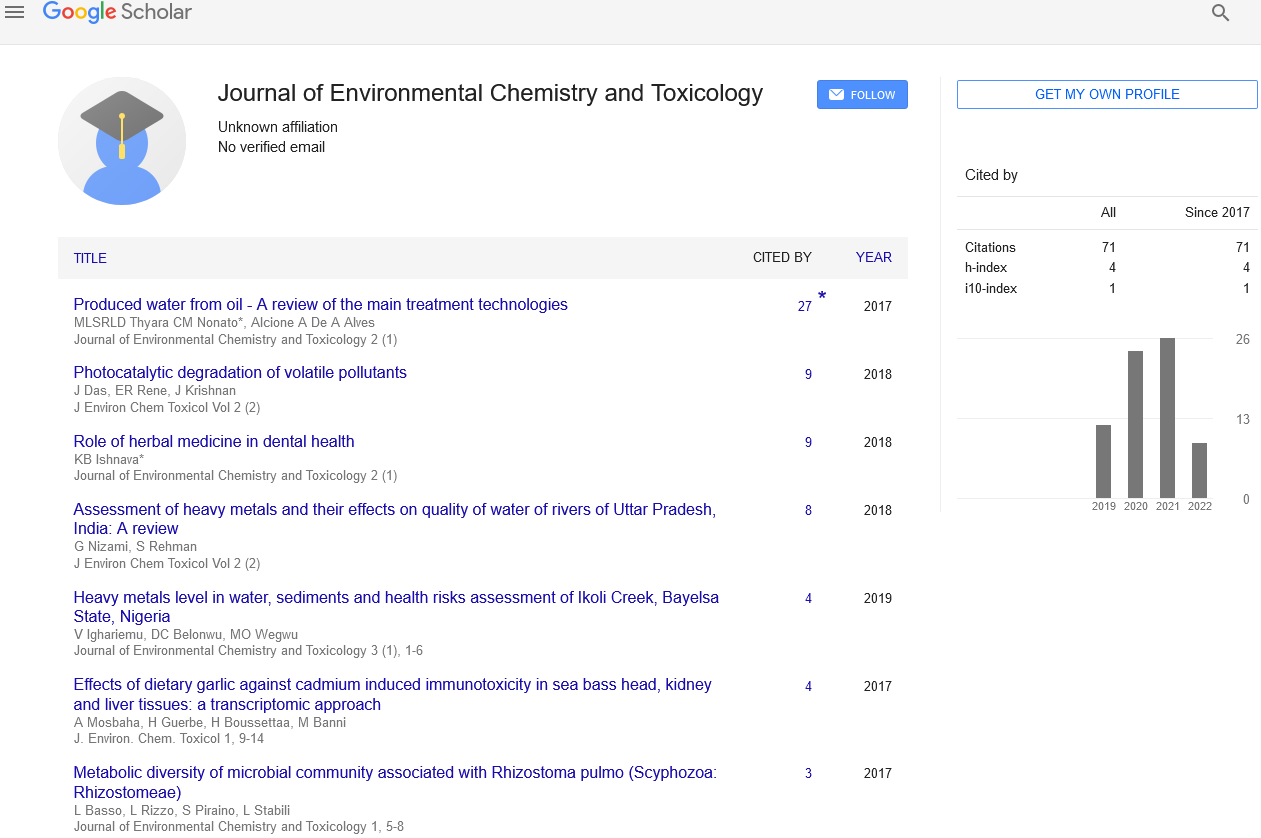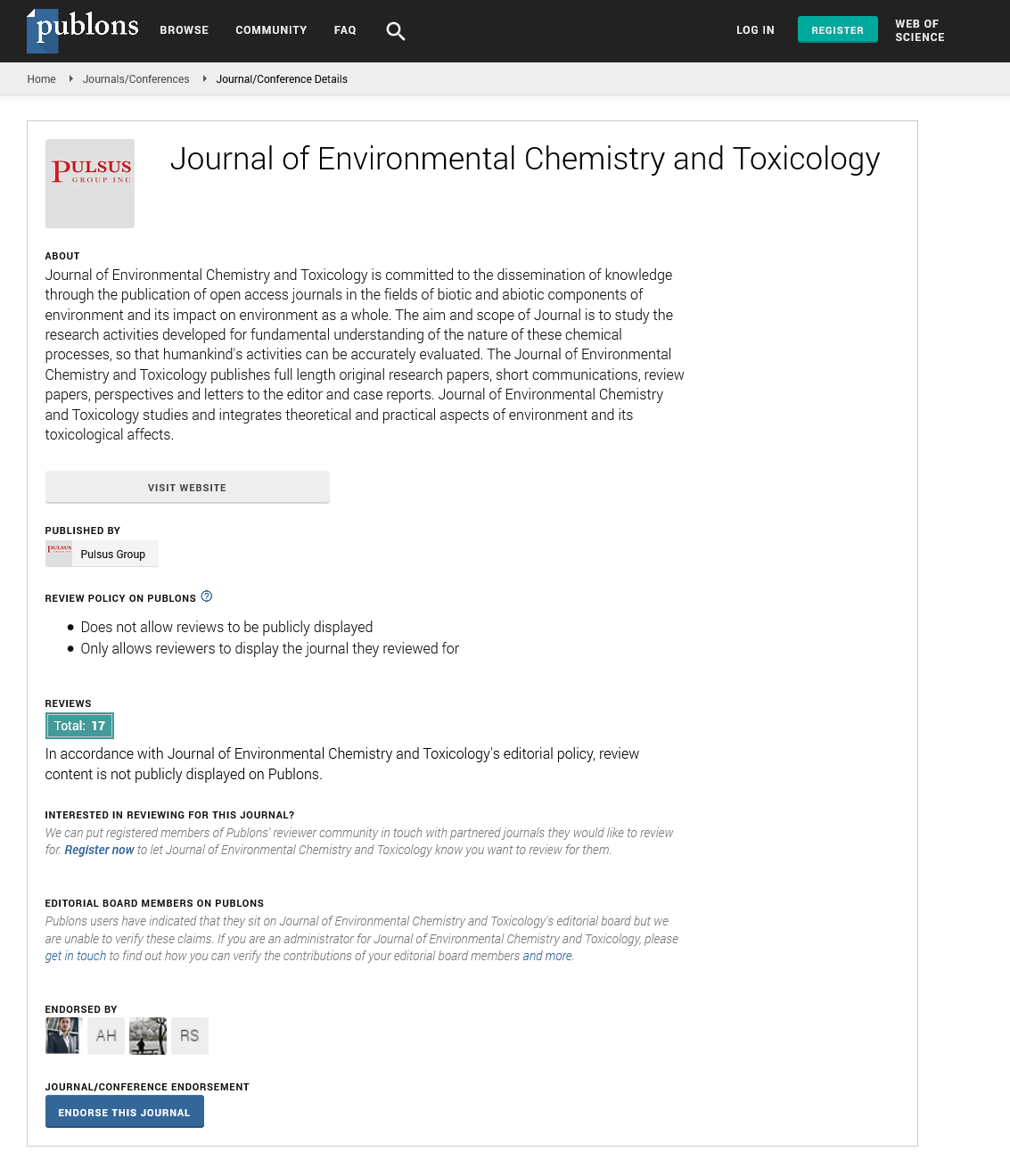Effects of insecticides on ground water
Received: 04-May-2022, Manuscript No. PULJECT-22-4954; Editor assigned: 12-May-2022, Pre QC No. PULJECT-22-49549(PQ0; Accepted Date: May 20, 2022; Reviewed: 14-May-2022 QC No. PULJECT-22-4954(Q); Revised: 16-May-2022, Manuscript No. PULJECT-22-4954(R); Published: 24-May-2022, DOI: 10.37532 pulject.2022.6(3);25-26
This open-access article is distributed under the terms of the Creative Commons Attribution Non-Commercial License (CC BY-NC) (http://creativecommons.org/licenses/by-nc/4.0/), which permits reuse, distribution and reproduction of the article, provided that the original work is properly cited and the reuse is restricted to noncommercial purposes. For commercial reuse, contact reprints@pulsus.com
Abstract
The effect of insecticides (S-metolachlor and propiconazole) and their respective foremost metabolites (ESA-metolachlor and 1,2,4-triazole) on bacterial denitrification in groundwater become studied. For this, the denitrification hobby and the bacterial range of a microbial network sampled from a nitrate-infected groundwater had been monitored throughout 20 days in lab experiments withinside the presence or absence of insecticides or metabolites at 2 μg/L or 10 μg/L. The kinetics of nitrate discount in conjunction with nitrite and N2O manufacturing all cautioned that S-metolachlor had no or best little effect, while its metabolite ESA-metolachlor inhibited denitrification with the aid of using 65% at 10 μg/L. Propiconazole and 1,2,4-triazole additionally inhibited denitrification at each concentrations, however to a lesser extent (29%–38%) than ESA-metolachlor. When inhibition occurred, insecticides affected the discount of nitrate into nitrite step. However, no massive variations had been detected at the abundance of nitrate reductase narG and napA genes, suggesting an effect of insecticides/metabolites on the protein stage in preference to on denitrifying micro organism abundance. 16S rRNA gene Illumina sequencing indicated no fundamental change of bacterial range withinside the presence or absence of insecticides/metabolites, besides for ESA-metolachlor and propiconazole at 10 μg/L that tended to growth or lower Shannon and InvSimpson indices, respectively. General boom parameters cautioned no effect of insecticides, besides for propiconazole at 10 μg/L that in part inhibited acetate uptake and prompted a lower in microbial biomass. In conclusion, insecticides and metabolites will have facet results at environmental concentrations on microbial denitrification in groundwater and can accordingly have an effect on environment activities. Atlantic Ocean websites displayed an extra blend of popular refuse. This look indicates that seabed muddle is ubiquitous on raised benthic capabilities, which include seamounts. It additionally concludes that the sample of accumulation and composition of the muddle is decided through a complicated variety of things each environmental and anthropogenic. We recommend that the tracing of fishing attempts and tools kind might be an essential step to clarify hotspots of muddle abundance on seamounts, ridges, and banks.changes belowground follow the same patterns as aboveground. Direct human actions such as soil sealing, agricultural land-use intensification, and biological invasions caused by the introduction of non-native species have all been shown to have a significant impact on soil biota populations. Abiotic conditions that have changed as a result of climate change have also had an impact on soil biodiversity.
Key Words
Soil biodivrsity
Introduction
One effect of the growing use of insecticides is the presence of each figure molecules and transformation products (metabolites) in numerous environmental matrices and extensively groundwater, with metabolites being even called rising groundwater contaminants. One disadvantage is that insecticides utilized in agriculture to goal insects, fungi, or vegetation are actually regarded to have facet consequences on non-goal floor and subsurface living (micro)organisms. The environmental effect of such facet consequences of insecticides and metabolites on microbial ecosystems is they can threaten the atmosphere offerings primarily based totally on microbial sports in soil (e.g., clutter degradation, plant growth, nutrient cycling, and degradation of pollutants) and groundwater (e.g., manufacturing of consuming water, nutrient cycling, degradation of contaminant). Most research at the facet consequences of insecticides were performed in soils, and the primary affects had been observed on microbial abundance, presence or absence of microbial species, growth or lower in gene [removed]specifically related to the N cycle), and growth or lower of useful variety [activities measured using the Biolog EcoPlates (C cycle) or soil activities linked to P, N, S, and C cycles. Moreover, the presence of insecticides turned into proven to typically result in the choice of microorganisms having the cappotential to degrade them.The modes of movements of insecticides are multiple, that can give an explanation for the variety of facet consequences determined on microbial groups and sports. In addition, the consequences of insecticides on soil microbial ecosystems specifically depend upon the sort of insecticides and their awareness, in addition to time after application. They additionally depend upon the microbial network shape and at the variety of the microbial techniques which can be taking vicinity withinside the studied soil. Physical and chemical elements including the sort of soil, pesticide awareness, presence of natural matter, and adsorption and desorption techniques additionally have an impact on the effect of insecticides on microbial groups. It turned into additionally proven that a few metabolites acquired after the organic and physicochemical adjustments of insecticides may be extra chronic and/or extra poisonous than the figure molecules. Taking all together, those elements growth the issue to assess the dangers related to insecticides use and to are expecting the internet consequences of insecticides on soil atmosphere health. In addition, contradictory conclusions at the affects of insecticides may be located amongst research because of the issue to evaluate effects from exceptional works performed with super variations in experimental setups, pesticide concentrations, and methods. The bioavailability/sorption/biodegradation of insecticides also can range lots for the equal insecticides in line with the studied system . The only a few research performed in groundwater have additionally underlined the capacity facet consequences of insecticides on groundwater microbial groups. Results first counseled that the presence of insecticides ought to growth microbial biodiversity. For instance acquired better Shannon and Simpson variety indices (from T-RFLP fingerprints) for groundwater groups in batch experiments amended with insecticides (metolachlor) in comparison with experiments with out the addition of insecticides additionally proven that the variety of colony morphotypes (culturable) in sediments from a subsurface aquifer uncovered to herbicides (as mixture) turned into better in comparison with the non-uncovered samples. These authors additionally determined an growth of the relative abundance of bacterial heterotrophs in aquifer sediment uncovered to insecticides, however no unique bacterial species had been located for herbicide-uncovered samples. additionally observed excessive variety indices from microbial network-degree physiological profiles (CLPP) the use of EcoPlatesTM in herbicide (isoproturon, atrazine, and acetochlor)-uncovered groundwater. Studies, however, underlined the problems to decide in situ the effect of insecticides on groundwater biodiversity because of herbal spatial and temporal versions of groundwater bacterial groups .Moreover, they counseled that biodiversity adjustments prompted with the aid of using insecticides had been now no longer related to modifications in wellknown catabolic properties. The function of the infection records of insecticides on its effect on groundwater microbial groups has additionally been underlined.
As an example, confirmed that during an aquifer impacted with atrazine over an extended time, a brand new infection with this pesticide results in the lower of the relative abundance of amoA gene and nitrite-oxidizing bacteria, even though ammonia is the number one degradation manufactured from atrazine. On the opposite, in an aquifer by no means impacted with atrazine before, atrazine spiking brought about an growth withinside the relative abundance of nitriteoxidizing bacteria. In every other study, confirmed that a triazine awareness of one µg/L turned into sufficient to result in amendment of the bacterial network shape in non-infected groundwater batch experiments, however a ten instances better (10 µg/L) triazine awareness turned into had to reap the equal effect in traditionally infected groundwater. The opportunity to extrapolate all of the expertise acquired for soil groups to groundwater ecosystems remains hard to establish. The first purpose is that the concentrations of insecticides in groundwater are low (in loads of nanograms to micrograms in keeping with liter order) in comparison with the ones located in soil, with metabolite contents typically better than figure molecules. The 2nd purpose is that aquifers are physically, chemically, and biologically exceptional from soil. Groundwater is certainly characterised with the aid of using a pretty consistent temperature (round 12°C-14°C in temperate climates), no sunlight, and a low without difficulty to be had nutrient content (low natural carbon and oxygen availability. Aquifers may be related to the floor however this connection significantly varies from an aquifer to every other, and switch fees may be so sluggish that a few aquifers may be taken into consideration as remote.






